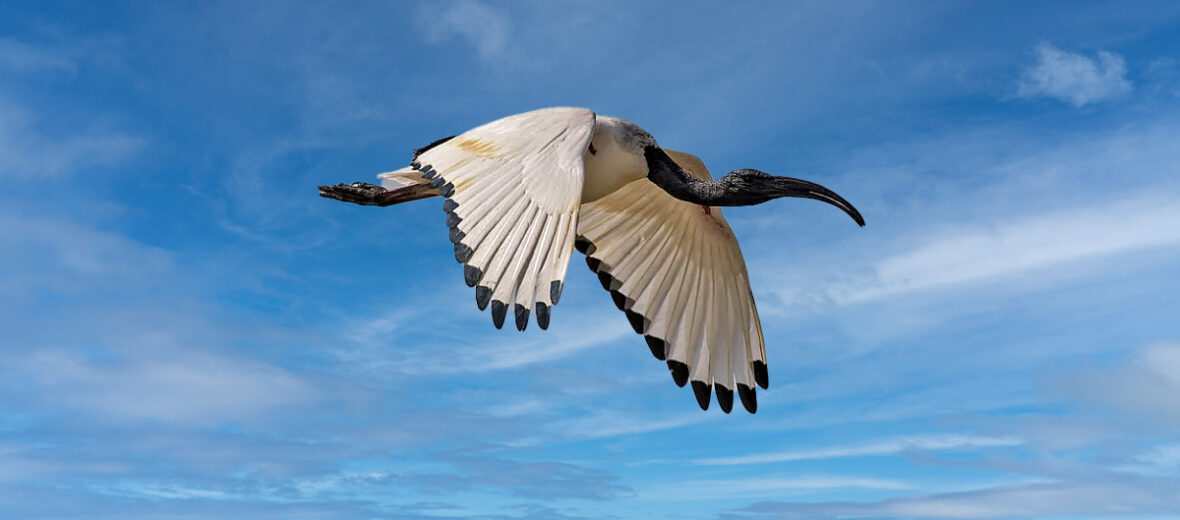
The African sacred ibis is a species of wading bird native to Africa. These birds were likened to the Egyptian god Thoth. Ironically, they have been extirpated from Egypt. There are also populations found in parts of the middle east. The sacred ibis may face the threats of hunting, trapping, intrusion from human activities, and invasive species – and with them disease, but they are still abundant enough to be listed as Least Concern by the IUCN. Their numbers are stable.
First the Stats…
Scientific name: Threskiornis aethiopicus
Weight: Up to 3.3 lbs.
Length: Up to 29.5 inches
Wingspan: Up to 49 inches
Lifespan: Up to 20 years
Now on to the Facts!
1.) There are approximately 450,000 wild individuals to date.
2.) They have also been introduced to France and Spain.
3.) While in mixed flocks these birds will often hybridize with other ibis species.
4.) Although typically silent, these critters can produce a puppy-like yelping sound.
5.) These birds prefer marshy wetlands and mud flats in both inland habitats and along the coastline.
But wait, there’s more on the African sacred ibis!
6.) African sacred ibises are diurnal (active during the day).
7.) Insects, worms, crustaceans, molluscs, invertebrates, various fish, frogs, reptiles, small rats & mice, carrion (dead animals), and sometimes seeds are all on the menu.
Did you know…?
For centuries the sacred ibis, along with other ibis species, were mummified by the Ancient Egyptians as a votive offering to the god Thoth. Over time, an estimated 8,000,000 birds were mummified and entombed by the Ancient Egyptians.
8.) They will also occasionally feast on broken pelican and other bird’s eggs.
9.) Seemingly their only natural predator is the African fish eagle.
10.) The African sacred ibis is also susceptible to avian botulism.
But wait, there’s still more on the African sacred ibis!
11.) Subsequently, a Physaloptera species of nematode has also been found in the orbital cavity of some sacred ibises.
12.) Breeding season is from March – August in Africa, but from April – May in the Middle East.
Did you know…?
It is widely believed that in order to sustain sufficient numbers for the large and often times growing need for sacrifices by the people, dozens of ibis breeding farms – called ibiotropheia by Herodotus – were built.
13.) Stick nests are often built in baobab trees. The nests are often built so close to one another that these birds bump into each other.
14.) Females lay up to 5 eggs each season that hatch in up to 29 days.
15.) Chicks fledge in up to 40 days and are independent in up to 48 days.
But wait, there’s still a little more on the African sacred ibis!
16.) Due to possibly a mistranslation of the Greeks of Herodotus, before the early 18th century Europeans were literally convinced that these ibises actually had human feet.
17.) Pliny the Elder stated that the flies that brought pestilence died immediately upon conciliatory sacrifices of these birds.
18.) In other falsehoods, Claudius Aelianus in De Natura Animalium, and Gaius Julius Solinus, were both quoted by much earlier however now lost authors as stating the sacred ibis procreates (reproduces) with its bill.
Now a Short African Sacred Ibis Video!
Be sure to share & comment below! Also, check out the Critter Science YouTube channel. Videos added regularly!
Want to suggest a critter for me to write about? Let me know here.
Some source material acquired from: Wikipedia & IUCN
Photo credit: Roberto Zuolo



